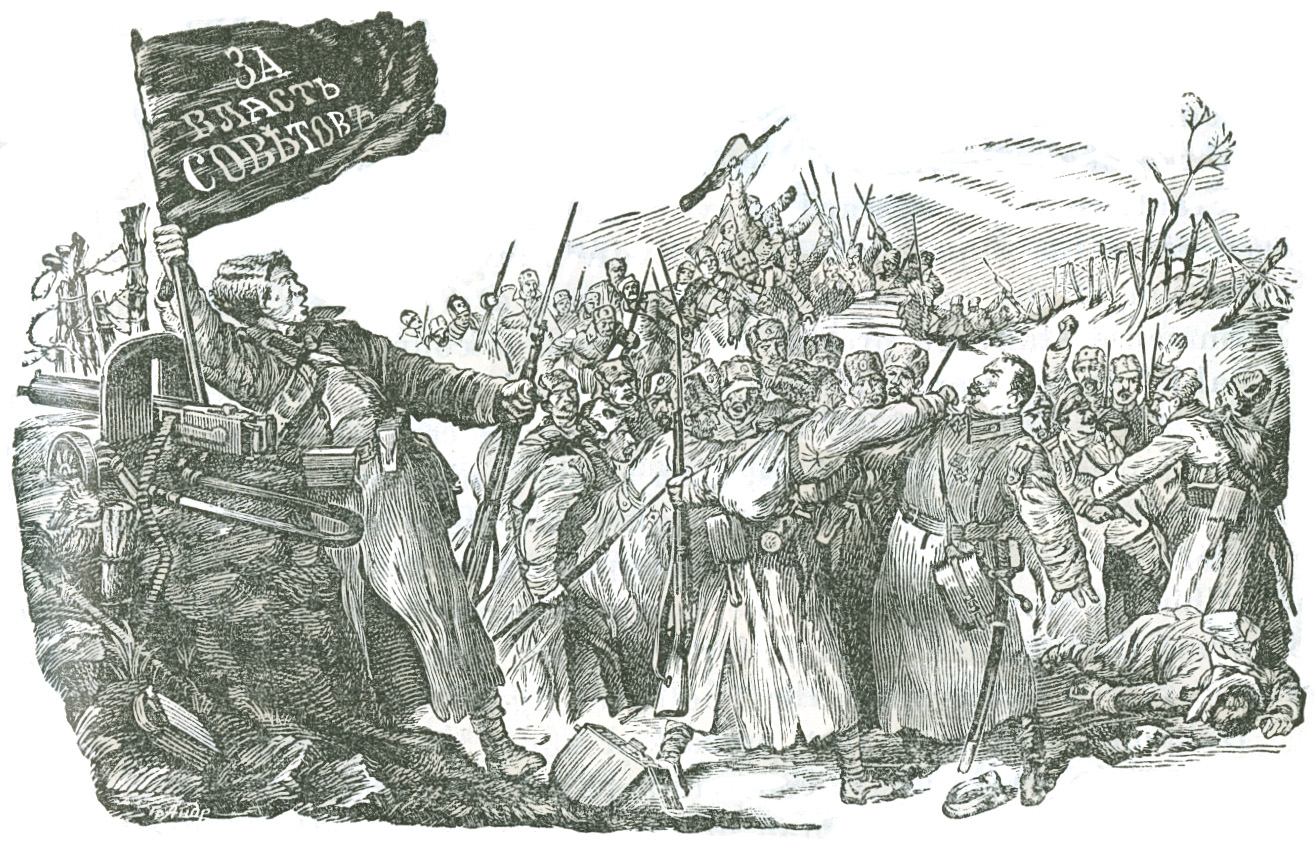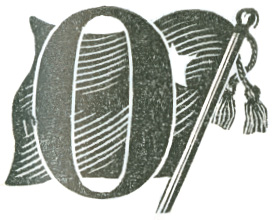


 n the night of October 25, General Baluyev, Commander-in-Chief of the Western Front, enquired of General Headquarters what action to take with regard to the telegrams he was receiving announcing the arrest of the Provisional Government.
n the night of October 25, General Baluyev, Commander-in-Chief of the Western Front, enquired of General Headquarters what action to take with regard to the telegrams he was receiving announcing the arrest of the Provisional Government.
“I request General Headquarters to give instructions, and immediately,” he said, “as I cannot conceal the telegrams of the Military Revolutionary Committee from the troops.”[1]
Next morning, General Dukhonin informed Baluyev what measures General Headquarters had taken.
“As telegrams are beginning to arrive with various orders from the Bolsheviks,” he stated, “we have appointed members of the Committee to be on constant duty at Headquarters in Moghilev and at the railway station to hold up the telegrams.”[2]
General Headquarters tried to conceal from the soldiers the news of the overthrow of the Provisional Government. Situated in the rear of the Western Front, in the backward provincial town of Moghilev, General Headquarters of the Supreme Commander-in-Chief served as the centre of concentration of the monarchist generals and army officers who constituted its immense staff. To protect this hotbed of counter-revolution the most “reliable” troops were retained, such as the 1st Shock Regiment and a battalion of Chevaliers of St. George. Numerous central bodies of the militarised bourgeois organisations, such as the Union of Zemstvos and Cities, and the War Industry Committee, also had their offices at General Headquarters. At the head of General Headquarters stood General N. N. Dukhonin, Chief of Staff of the Supreme Commander-in-Chief. Actually, he was the Supreme Commander-in-Chief, for Kerensky, who officially held that post, was merely a straw man, the “political figurehead.”
Dukhonin had only just embarked upon his high career. At the beginning of the war he was in command of a regiment and later served as Quartermaster-General on the Staff of the South-Western Front. He had been appointed Chief of Staff of the Supreme Commander-in-Chief only in September 1917. Dukhonin was a monarchist. In view of the situation which had arisen he, as General Denikin wrote subsequently, “very reluctantly travelled with the revolutionary democracy.”[3] He hoped, with the assistance of all sorts of conciliation committees, to restore the discipline of the rod in the army and to continue the war to a “victorious finish,” but he was doomed to disappointment.
Dull and narrow-minded, Dukhonin acted entirely in conformity with the advice and instructions of that outstanding personality in the camp of the counter-revolution, General Alexeyev, Chief of Staff of the Supreme Commander-in-Chief under Nicholas II and later under Kerensky. As General M. D. Bonch-Bruyevich stated:
“Alexeyev had such enormous influence upon Dukhonin that before issuing any order the latter always consulted Alexeyev on the direct wire.”[4]
At General Headquarters there was an All-Army Committee, consisting of 25 members, each representing one of the fronts, armies, fleets, and so forth. As was the case with all Army and Front Committees which had been elected in the spring or summer, the majority of the members of the All-Army Committee were either Mensheviks or Socialist-Revolutionaries. The Committee played no independent role whatever; it merely rubber-stamped the orders of General Headquarters. A characteristic example of this is quoted by the Whiteguard A. A. Dickhof-Derenthal, who was at General Headquarters at that time.
“One day, shortly before the Bolshevik insurrection, the All-Army Committee that had been set up at General Headquarters sent Kerensky one of their ‘regular documents’ commencing with the words: ‘We demand. . . .’
“Kerensky returned this document with the following marginal note:
“‘The All-Army Committee has no right to “demand” anything from its Supreme Commander-in-Chief. . . . It may only “request.”‘
“This incident found its way into the press and General Dukhonin was beside himself with rage over it.
“‘How can such things be communicated to journalists?’ he asked indignantly.
“But . . . time passed . . . no earthquake resulted from this affront to democratic majesty and, calming down, General Dukhonin himself began, in his sprawling handwriting, to blue-pencil the ‘demanding’ telegrams with the stereotyped comment: ‘They have no right to demand!‘”[5]
The Chairman of the All-Army Committee was Staff Captain S. N. Perekrestov, a resolute opponent of the Soviet Government and a zealous supporter of General Dukhonin.
The Moghilev Soviet of Workers’ and Soldiers’ Deputies was controlled by the Mensheviks, Bundists and Socialist-Revolutionaries. The Soviet of Peasants’ Deputies entirely followed the lead of the Socialist-Revolutionaries. There was no independent Bolshevik organisation in Moghilev right up to the October days; there was only a Bolshevik group in the united Social-Democratic organisation.
The army disliked General Headquarters, was suspicious of it, and regarded it as being mainly responsible for the failure of military operations. As Lenin wrote:
“The Kornilov mutiny fully revealed the fact that the army, the entire army, hates General Headquarters.”[6]
The suspicions of the rank and file of the army were fully confirmed during the October days. General Headquarters were the first to attempt to hinder the Soviet Government’s efforts for peace. More than that, General Headquarters came out in opposition to the Soviet Government. On October 26, Dukhonin sent telegrams to the Commanders-in-Chief of the different fronts and to other high army commanders in which he explained the attitude of General Headquarters towards the prevailing situation as follows:
“General Headquarters, the Headquarters Commissar and the All-Army Committee share the point of view of the government and have decided to do everything to prevent the army from falling under the influence of the insurgent elements and at the same time to render the government full support.”[7]
This was the program of action of General Headquarters and of the supreme army organisations at Headquarters.
For a whole week—from October 25 to November 1—Dukhonin was in direct telegraphic communication with the high commands of the different fronts, probing the possibilities of mobilising reliable units for the purpose of suppressing the revolution and issuing orders in that direction. On October 28, in a conversation on the direct wire with General Lukirsky, Chief of Staff of the Northern Front, he said:
“Units have been sent from the South-Western Front to Kiev to deal with the Bolsheviks.”[8]
In a telegram addressed to the Supreme Commander-in-Chief, dated October 31, he stated that “all measures are being taken” to reinforce the government troops in Moscow. At the same time he tried to make arrangements for the reliable units to occupy the strategically most important points on the routes to Petrograd and Moscow. In his conversation with General Lukirsky he stated:
“I have given orders to the troops of the 17th Corps firmly to hold the railway stations at Dno and Orsha. These orders have probably been carried out. The officer sent on a locomotive to investigate and verify has not yet returned.”[9]
In conformity with instructions of General Headquarters, Aristov, chairman of the committee for forming shock battalions, reported on October 31 that the shock battalions scattered over the different fronts were ready for action against the Bolsheviks. In a telegram addressed to the All-Russian Executive Committee of the Railwaymen’s Union, published on October 31, the All-Army Committee stated: “All measures undertaken by General Headquarters are carried out under our supervision.”[10] Thus, the compromisers on the All-Army Committee took General Headquarters under their wing.
General Headquarters was extremely lavish with threats. It issued orders right and left demanding that the Bolshevik insurrection be stopped, threatening that the entire army on active service would back this demand by force. On October 31, Dukhonin sent a telegram to Novocherkassk, addressed to M. Bogayevsky, the second in command of Ataman Kaledin, the leader of the monarchist counter-revolution that was being organised in the Don Region. This was in reply to Bogayevsky’s offer to organise a punitive expedition against the Bolsheviks. Dukhonin stated:
“The Cossacks’ readiness to become the guardians of public security is a stand-by to us all at this difficult juncture. . . . We shall fight to the very utmost to restore the Provisional Government and the Council of the Republic, and thereby restore order in the country.”[11]
The extensive mobilisation of counter-revolutionary forces conducted by General Headquarters came to an abrupt end on November 1. By that time Dukhonin had received news of Krasnov’s capitulation near Petrograd, and of Kerensky’s flight. On November 1 he issued an order announcing that he had taken up the duties of Supreme Commander-in-Chief. In the same order he stopped the movement of troops to Petrograd. After all the threats he had uttered to crush the Bolsheviks, this was tantamount to a confession of the failure of the “crusade” which he had planned. Dukhonin adopted a waiting attitude, meanwhile drawing “reliable” units to General Headquarters.
[1] “Documents,” Archives of the Russian Revolution, Vol. VII, Berlin, 1922, p. 305.
[2] Ibid., p. 315.
[3] A. I. Denikin, Sketches of the Disturbances in Russia, Vol. II, Paris, 1922, p. 144.
[4] M. D. Bonch-Bruyevich, Materials of the Secretariat of the Head Editorial Board of The History of the Civil War, Fund of Volume II of “H.C.W.”
[5] A. Dickhof-Derenthal, “Silhouettes of the October Revolution,” in Perezhitoye (Things Lived Through). In the Year of Revolution, Verf Publishers, Moscow, 1918, Vol. I, pp. 53-54.
[6] V. I. Lenin, “Draft Resolution on the Political Situation,” Collected Works, Eng. ed., Vol. XXI, Book I, p. 161.
[7] “October at the Front,” Krasny Arkhiv, 1927, Vol. 4 (23), p. 156.
[8] Ibid., p. 170.
[9] Ibid.
[10] “Appeal of the All-Army Committee to the All-Russian Executive Committee of the Railwaymen’s Union,” Bulletin of the All-Army Committee, No. 4, October 31, 1917.
[11] The 1917 Revolution in Historic Documents, Tiflis, 1930, pp. 160-161.
Previous: The Capitulation of the Whites
Next: The October Days at the Northern Front